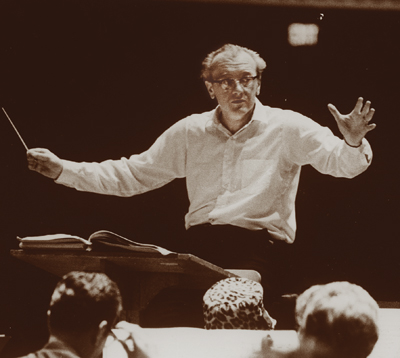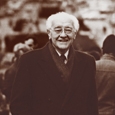
At the mention of composer Karel Husa, most instrumental conductors recall Music for Prague 1968, Apotheosis of This Earth, and other staples in the advanced repertoire for band and orchestra. Less known are his compositions for student groups. The following are my comments on the ensemble and chamber music of a Pulitzer Prize-winning composer that falls well within the technical abilities of many high school ensembles. Husa explains, “Writing for young or amateur musicians is nothing new. Bartók arranged folk songs and Hindemith wrote Gebrauchsmusik that allows musicians of all abilities to play their music.”
Music for Full Orchestra
Celebration Fanfare (Associated Music Publishers/G. Schirmer) was commissioned and written in 1996 for the 50th anniversary of the Hartwick (New York) College Summer Music Festival and Institute. Charles Schneider conducted the festival orchestra in the first performance on July 7, 1996. Scoring is for three flutes, two oboes, English horn, two clarinets, bass clarinet, two bassoons, contrabassoon, four horns, four trumpets, three trombones, tuba, three percussion, timpani, and strings. Grade 3 string and percussion sections and grade 4 winds could handle this rousing concert opener. It is a two-minute work primarily of quarter and half notes with no difficult rhythms beyond rare dotted eighth-16th triplets. Violins only shift positions in the last eight measures on sustained notes. Although written for four C trumpets, the highest note is an A5 on the final chord.
Music for String Orchestra
Vier kleine Stücke (Four Little Pieces, Schott) is a delightful grade 2-3 work first performed at a youth music festival in Fürsteneck, Germany in 1957. String parts remain in first position so students who have not been introduced to shifting can learn it. The most complicated rhythmic element is some hemiola, which might be best taught by rote. In the first movement, a theme and variations, the theme is treated as a march, a gavotte, an elegy, a siciliano, and a dance, ending with a finale that has some clever counterpoint. The adagio second movement, “Notturno,” creates moods with dark, muted colors. The third movement, “Furiant,” recalls the hemiola two-versus-three Slavonic dance associated with Dvorák and Smetana. The final movement is a coda to the entire 15-minute work characterized by weighty playing and modal harmonies. A good introduction to the earlier work of a major contemporary composer, this excellent piece introduces a variety of string colors.
Pastoral (1979, Associated Music Publishers) is a seven-minute work commissioned by the American String Teachers Association. The A.S.T.A. National String Orchestra premiered it in Miami in April 1980 with the composer conducting. A slow, simple theme begins in the first violins, and the other strings gradually join. Although the rhythms are mostly simple, players should be confident with wide melodic leaps (there are many minor 9ths) and divisi parts in all sections. First violins shift to fifth and sixth positions. This grade 5 piece exposes players to expressionistic colors and harmonies.
In addition to his original compositions, Husa edited two easier arrangements of ballet suites by the French Baroque composer Jean Baptiste Lully (1632–1687). These works, entitled La Ballet des Muses (Associated Music Publishers) and Le Carnival, Mascarade (Bärenreiter), date from the late 17th century. Much Baroque music played today is by Handel and Bach, so here is a rare opportunity to perform grade 3 and 4 French Baroque music. Both suites have numerous movements, and the sets run about 18 minutes each. Performing only selected movements is acceptable. In the notes on each arrangement Husa explains how to seat string players in the manner of Lully’s ensemble, the Vingt-quatre Violons du Roy (The King’s 24 Violins). Because Lully often wrote for five parts, this edition divides the violins into three groups, with one group of violas and one consisting of cellos and basses. This balances the ensemble better than Lully’s original arrangement of two violin parts and two viola parts, especially because many young orchestras have few violas. The keyboard part is realized from the figured bass but kept simple so that a more experienced player could improvise in the basso continuo style. Lully’s ornamentation is written out so it can be read easily by young players. Flutes, oboes, and bassoons commonly doubled the strings in Lully’s time, so winds may be added.
Music for Flexible Instrumentation
Festive Ode (G. Schirmer) is a four-minute celebratory piece for chorus and full orchestra, wind symphony, or brass ensemble with percussion, and each ensemble has flexible instrumentation. English horn, contrabassoon, second and fourth horns, and tuba may be omitted from the orchestral version, and the brass ensemble edition requires a minimum of two horns, three trumpets, three trombones, tuba, timpani, and two percussionists. The score calls for SATB chorus but it may be sung TTBB with slight alterations. Rhythms are easier but the ranges make the work a grade 5.
Festive Ode was composed for the centennial celebration of Cornell University in 1964. Thomas Sokol conducted the university’s chorus, glee club, and symphony orchestra. Extensive unison writing in the chorus and instrumental parts accommodates the usual lack of rehearsal time associated with massed ensembles and produces a strong sound even in large, acoustically poor spaces.
Husa adapted texts from Eric Blackall and Thomas Martin that are inspiring and appropriate to any formal academic celebration:
Gaudeamus! Let us now rejoice and give praise to those of high renown, who in this place gave us our foundation; For this is our heritage, our inspiration and our joy.
Here we stand, hearts aflame with desire for truth in the firm pursuit of knowledge; For the truth that is not known; In widening horizons we dwell, we shall come forth and say: “We know.”
Reach forth, seek, strive, take pride! Praise! Give thanks!
Performance materials are only available on rental from the publisher.
Music for Chamber Ensemble
Musique d’amateurs: Quatre pièces faciles pour hautbois, trompette, batterie, et orchestre à cordes (Music for Young Players: Four Easy Pieces for Oboe, Trumpet, Percussion [bass drum, cymbal, tambourine] and Strings) has an unusual history. Commissioned by United Nations Educational, Scientific, and Cultural Organization in 1952, Husa wrote this piece for full band, his first work for that medium. Husa shipped the score and parts, but they were lost and never performed. Schott published a reconstructed version for chamber ensemble. True to its title, the string parts never go beyond third position and the trumpet range tops out with a single F#5. The oboe part uses the instrument’s full range, with sustained Bs and Cs below the staff and nimble Cs and Ds above, but the score suggests that a clarinet could cover the lower range passage. The movements of this grade 3 piece are entitled “Intrada,” “Scherzo,” “Aria,” and “Danza,” and expressions range from playfulness to introspection. If efforts to recover the original score and parts succeed, this could become a significant contribution to intermediate band repertoire.
Music with Several Versions
Husa’s educational four-movement Divertimento for Brass and Percussion (Associated Music Publishers, 1958) has undergone numerous metamorphoses. It began as part of Eight Czech Duets for piano four hands that Husa wrote for his children in 1955. It was rearranged by the composer for brass quintet (1974), arranged for symphonic winds and percussion by John Boyd (Ludwig) in 1995, and arranged for flute, clarinet, and piano in 2003 by Michael Webster as part of Eight Bohemian Sketches. In whatever configuration, this displays the composer’s musical roots in the Czech Republic. The versions are grade 4 except for Boyd’s band arrangement, which is grade 5. It is modest in rhythmic difficulty and range but uses earthy harmonies and peasant-like material.





